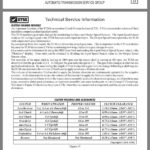The P0720 diagnostic trouble code (DTC) indicates a problem with the Output Speed Sensor (OSS) circuit. This generic powertrain code applies to OBD-II equipped vehicles, impacting various makes and models. Understanding this code is crucial for effective diagnosis and repair.
What Does the P0720 Code Mean?
In modern vehicles with electronically controlled transmissions, the OSS plays a vital role. Located at the transmission’s output shaft, it monitors the shaft’s rotational speed. This data informs critical functions like shift scheduling, torque converter engagement, and Electronic Pressure Control (EPC). When the Powertrain Control Module (PCM) or Engine Control Module (ECM) detects a malfunction in the OSS circuit, it triggers the P0720 code. While the vehicle may continue to operate, the PCM/ECM might rely on estimated values from other sensors, potentially affecting performance. The OSS also commonly contributes to speedometer readings.
Typical location of the output speed sensor
On some vehicles, the OSS sensor shares a circuit with the Transmission Fluid Temperature (TFT) sensor. A faulty TFT sensor or its wiring can indirectly trigger the P0720 code. If you encounter both a P0720 and a TFT-related code, investigate both sensors and their shared wiring. Codes P0721, P0722, and P0723 are related to the P0720 and indicate different OSS circuit issues.
Recognizing Symptoms of a P0720 Code
A P0720 code can manifest in various ways, including:
- Delayed or erratic shifting: The transmission might struggle to shift gears smoothly or at the correct time.
- Malfunctioning speedometer: Inaccurate or non-functional speedometer readings are common.
- Illuminated Check Engine Light: The most obvious symptom, signaling a diagnosed issue.
Illuminated Check Engine Light
Potential Causes of a P0720 Code
Several factors can contribute to a P0720 code:
- Faulty Output Speed Sensor: A defective OSS sensor is the most likely culprit.
- Wiring or Connection Issues: Damaged, corroded, or loose wiring and connections within the OSS circuit can disrupt signal transmission.
- Malfunctioning Transmission Fluid Temperature Sensor: As mentioned earlier, a faulty TFT sensor can indirectly cause a P0720 code in some vehicles.
Diagnosing and Repairing a P0720 Code
1. Inspect the Output Speed Sensor:
- Visual Inspection: Examine the OSS sensor for physical damage, especially to the plastic gear if applicable. Replace if necessary.
- Resistance Test: Using a Digital Volt Ohm Meter (DVOM), check the sensor’s resistance against manufacturer specifications. A reading outside the specified range indicates a faulty sensor.
- Power and Signal Check: Verify power supply to the sensor and the signal reaching the PCM/ECM. Use a wiring diagram for reference.
- Duty Cycle Test (if applicable): If the OSS shares a circuit with the TFT sensor, a duty cycle test using a graphing voltmeter or oscilloscope can reveal voltage drops or inconsistencies, pointing to potential problems in the sensor, wiring, or TFT sensor.
2. Inspect the Wiring and Connections:
- Visual Inspection: Thoroughly examine the wiring harness for loose connections, damaged wires, or corroded terminals.
- Continuity Test: Use a DVOM to check for continuity and excessive resistance in the wiring between the sensor, TFT sensor (if applicable), and the PCM/ECM.
- Short Circuit Test: Test for shorts to ground or power in the wiring harness.
3. Check the Transmission Fluid Temperature Sensor (if applicable):
- Resistance Test: Use a DVOM to check the TFT sensor’s resistance against manufacturer specifications.
- Short Circuit Test: Test for shorts to ground within the TFT sensor circuit.
- Power Supply Check: Verify power supply from the PCM/ECM to the TFT sensor.
Conclusion
Addressing the Eobd/obdii P0720 code requires a systematic approach, starting with a thorough inspection of the OSS sensor, its wiring, and potentially the TFT sensor. Using a DVOM and referencing a factory wiring diagram are essential for accurate diagnosis. If you’re uncomfortable performing these checks, consult a qualified mechanic. Proper diagnosis and repair ensure the smooth and efficient operation of your vehicle’s transmission system.

